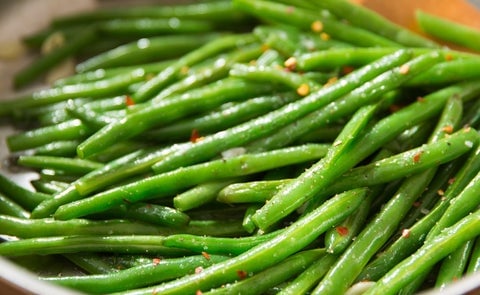Green Bean Nutrition
What would Thanksgiving dinner be without Green Bean Casserole? The dish, created by the Campbell Soup Company in 1955, is now a staple throughout the US – in 2018, it was served in an estimated 20 million households during the holiday. It’s enduring popularity stems from the abundance of, relative cheapness, and deliciousness of green beans, long a pantry staple and a super nutritious vegetable in its own right.
Green beans are the unripe, young fruit of various cultivars of the common bean (Phaseolus vulgaris), and have a number of close relatives (such as runner beans). Originating in Central and South America, there's evidence that they’ve been cultivated in Mexico and Peru for thousands of years, and have been an important part of various cultures’ diets for centuries. Known by many common names, such as string beans, snap beans, and French beans – the French themselves call them haricot vert – they are distinguished from the many other varieties of beans in that they're harvested and consumed with their enclosing pods, before the bean seeds inside have fully matured.
Not only are green beans healthy, nutritious, and delicious, they are also versatile. They are sold fresh, canned, and frozen, and can be prepared a number of ways, including steamed, boiled, stir-fried, or baked. And at just 31 calories per serving, and containing no cholesterol, virtually no fat, and very little sugar, there are many benefits to including them in your diet.

Green beans are great for your heart. One cup of raw green beans has 2.7g of fiber, with cooked (boiled) beans containing 4g of fiber, all of which may help lower LDL or so-called bad cholesterol and total cholesterol levels. It also helps with lowering blood pressure and reducing inflammation. Green beans are naturally low in sodium too – one cup has only 6.6 milligrams – which is also great for heart health; the American Heart Association recommends eating no more than 1,500 milligrams of sodium daily.
That fiber helps to keep the digestive system and your gut healthy and running smoothly as well. Green beans are a low FODMAP food - FODMAPs are undigested carbohydrates that are metabolized by bacteria in your gut leading to gas, belly pain, diarrhea, and constipation – meaning they can be enjoyed by many people who have chronic digestive issues or suffer from irritable bowel syndrome.
Green beans contain protein – one cup of raw beans packs almost 2g of it – and they also contain many essential vitamins and minerals. One cup of raw green beans contains 33 micrograms of folate, a B vitamin that helps prevent neural tube defects and other birth defects, which is almost 10 percent of the daily recommended value. They’re also a great source of vitamin C, an antioxidant that boosts the immune system and the production of collagen (which helps protect your skin from oxidative stress), and vitamin A, a retinoid that’s important for the body’s immune system, reproduction, and healthy vision.
They’re also packed with manganese, an essential mineral that supports metabolism and bone health and promotes wound healing, and are rich in potassium, phosphorus, and calcium. Vitamin K too, a group of vitamins that the body needs for blood clotting, bone metabolism, and helping wounds to heal.
Of course, fresh green beans are the healthiest - look for beans that are bright green and free of black spots and blemishes – but frozen is fine too. Just be sure to cook them from frozen, and to not overcook them – thawing and boiling too long can cause a reduction in some nutrients such as vitamin C. We have some great, organic green beans, both fresh and frozen, so stick some in your cart today and see for yourself how healthy – and delicious – they are.

